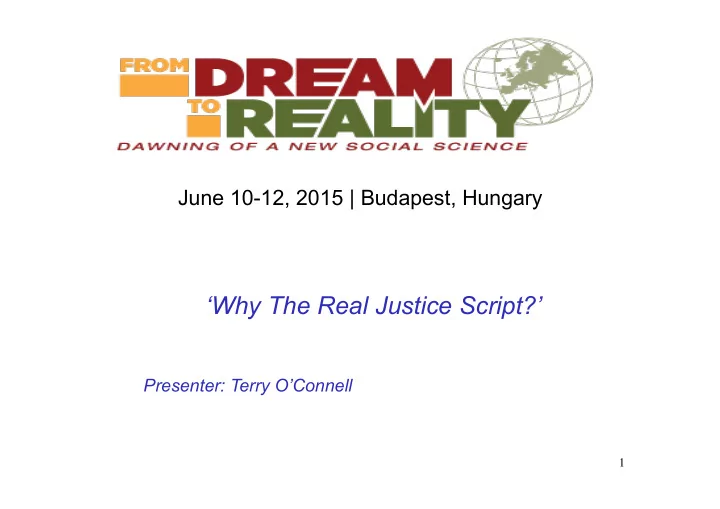

June 10-12, 2015 | Budapest, Hungary ‘Why The Real Justice Script?’ Presenter: Terry O’Connell 1
Welcome & Reflection • What attracted you to this workshop? • Who uses the IIRP conference script? How does it help? • Who uses another script? Why do you use this script? • If your script worked what would you see happening for those involved? • What would you like to take from this workshop? 2
Brief History • My first [informal] conference facilitated in 1973. • Policing context in Wagga Wagga – 1989. • New Zealand FGC – 1990 [John MacDonald] • First formal conference – 1991 • Connected with John Braithwaite ANU – 1991 • David Moore [CSU] connected with Don Nathanson - 1992 • Script questions printed on business cards – 2001 3
My Starting Point - Working Assumptions What are working assumptions and why are they necessary? Let’s develop a set of working assumptions: • List those things that those who are likely to be involved in a ‘conference’ have in common - victims, offenders and their families? • Divide these into the following two categories: causal factors and symptoms. Now develop your working assumptions. What implications do your working assumptions have for your practice? 4
What keeps you and I out of relationships? Vulnerability keeps us in and out of relationships – discuss. What affect [emotion] triggers vulnerability? What purpose does shame have? What would a positive response to shame involve? What would a negative reaction to shame involve? 5
My Practice My practice aims to build relational capacity and involves facilitated dialogue that seeks to: • assist others to make sense and meaning of their own lives, • help them identify what is most important in all that is happening, • identify what needs to change and what their part will be in this change process, and importantly, • focus on what they need to help build and sustain healthy relationships. What practice is needed to create the conditions that will best support participants being able to achieve the above outcomes? Where would you begin to describe or develop such practice? 6
Tomkins’ Blueprint : • We are ‘wired’ to want to increase positive affect, and; • Decrease negative affect; • We live at our best when we can accomplish these two goals; • Anything that increases our power to do this favours life. 7
Nathanson 1992 8
9
10
Restorative Practice Checklist 11
Restorative Practice Framework - Right Conversation Restorative Focus Harm & Relationships Fair Process - explicit Creating Conditions: • Engagement – say Reintegration • Explanation - reasons Blueprint Relationships • Expectation clarity - managing shame - explicit New Stories Enhanced Capacity Strong Relationships Working ‘With’ High expectations & Restorative Questions High levels of support Socratic Engagement - relational style - common language 12
Restorative Practice Continuum Restorative Small Group Formal Restorative Conversation Impromptu Circle Conference Intervention Meeting 13
Restorative Engagement Journey Metaphor Past Present Future What Am I Wanting? What’s My Story? Where Am I Now? 14
Restorative Journey Script Protocols Offenders Victims Script Sequence Past Victims’ families & Supporters Offenders’ families & Supporters Offenders Victims Present Offenders Others generally Future 15
Braithwaite’s Theory & Script Protocols Offenders Victims Script Sequence Victims’ families & Supporters Offenders’ families & Supporters Offenders Max Shame Victims Offenders Others generally Reintegration Begins 16
Tomkins Theory & Script Protocols Offenders Victims Script Sequence Victims’ families & Supporters Offenders’ families & Supporters Offenders Negative Emotions Victims Offenders Others generally Positive Emotions 17
Conf onferenc nce Pr Protoc otocols ols Person Responsible For Harm Victim And His/Her Support Family/Supporters Of Person Responsible Person Responsible For Harm “Anything To Say”? Ask Victims & Others About What Needs To Happen Agreement Phase Closure And Reintegration Phase 18
Questions & Feedback • What questions do you have? • What have you taken from this workshop? • What changes to your practice are you likely to make as a result of today’s experience? 19
Recommend
More recommend